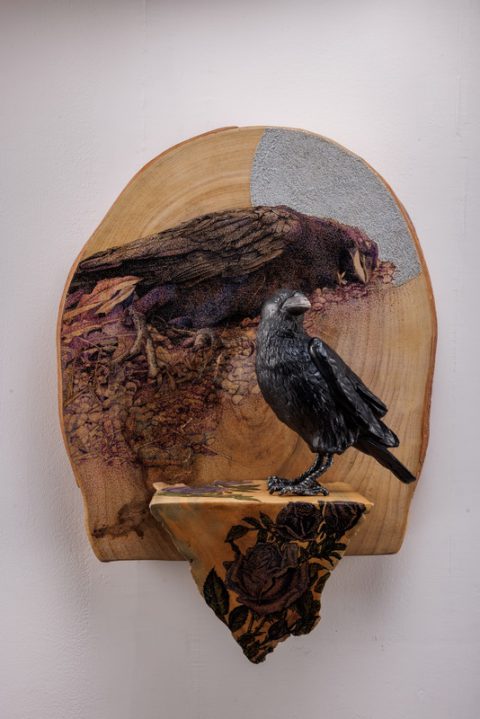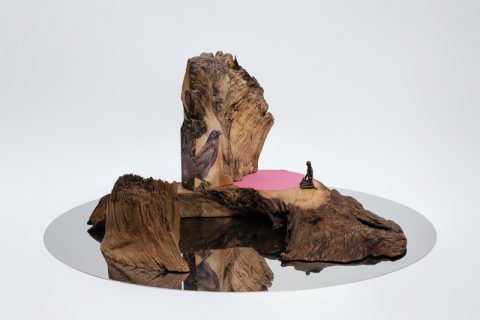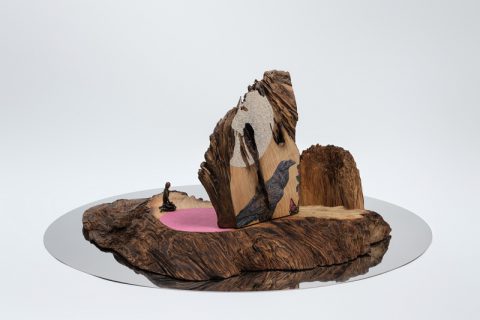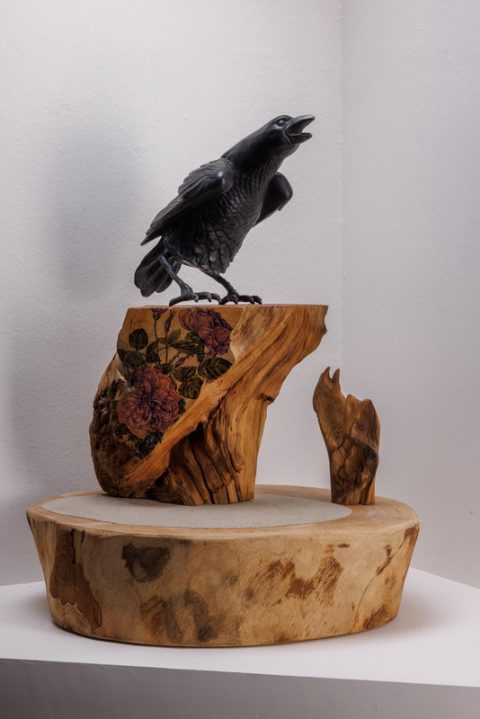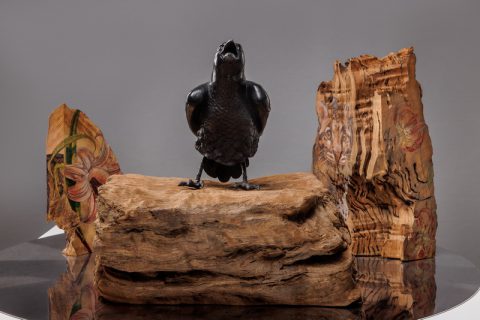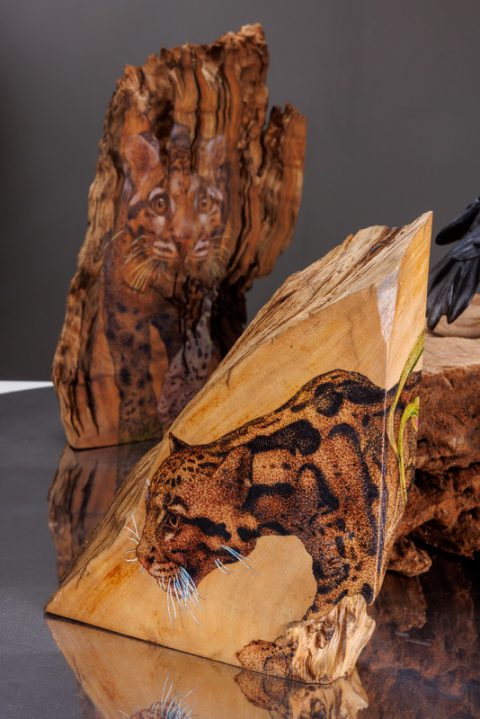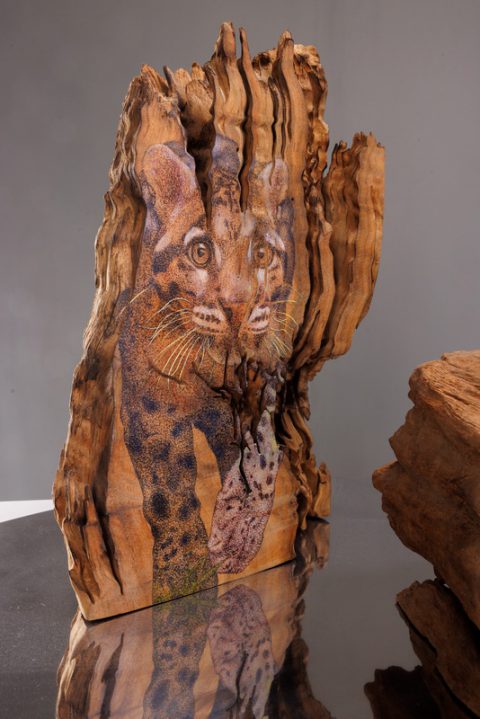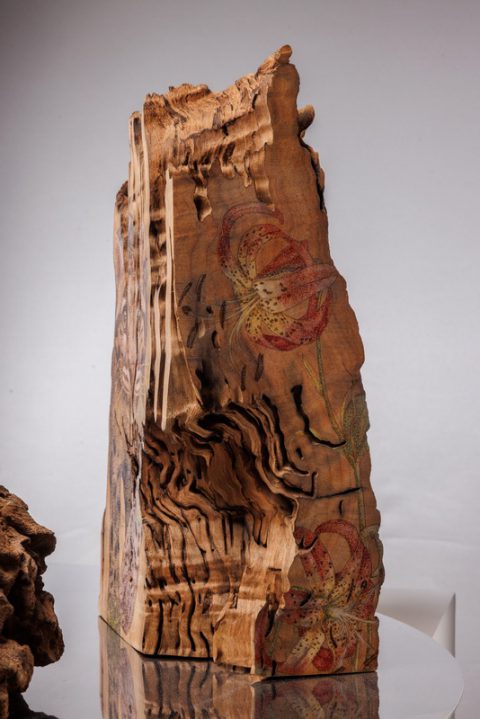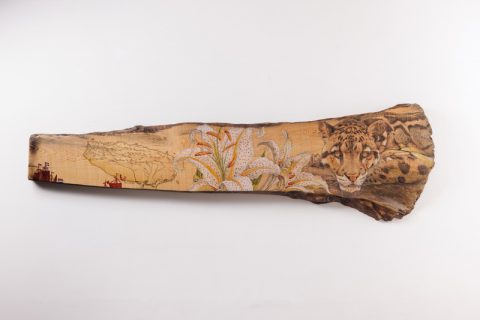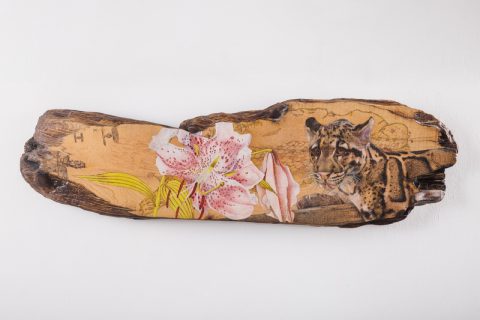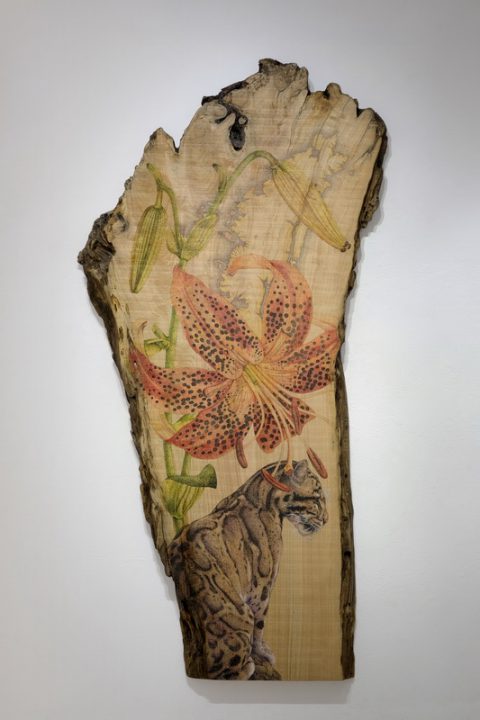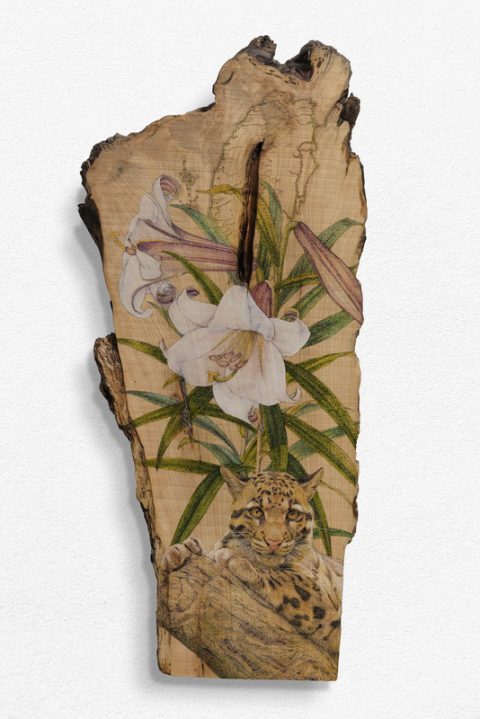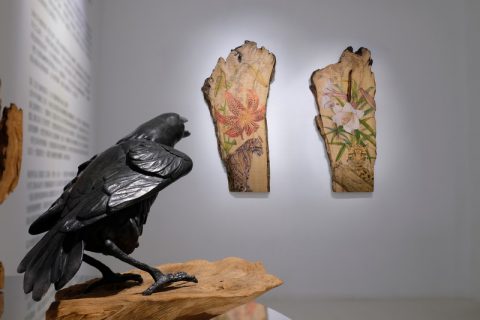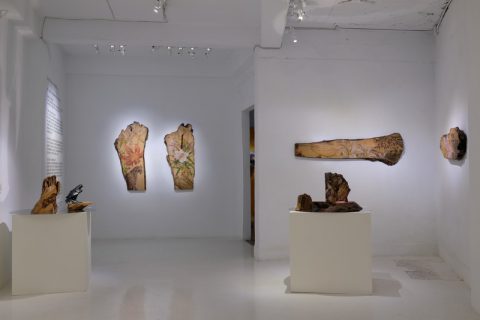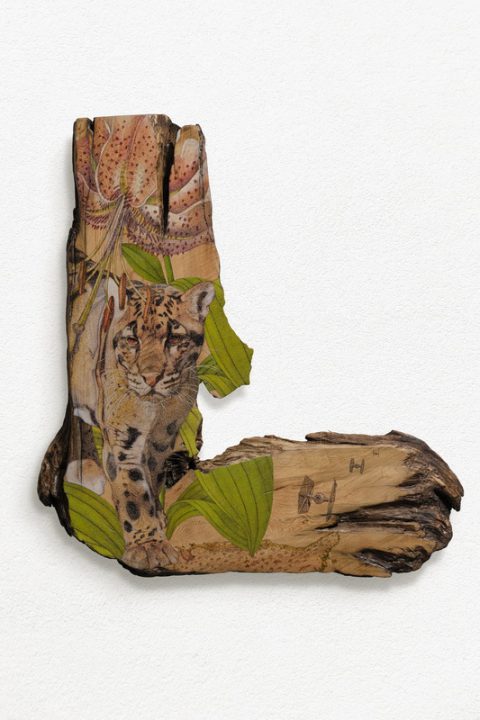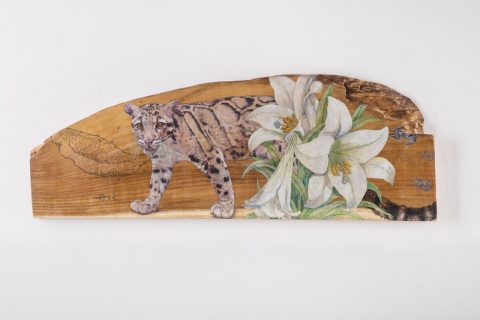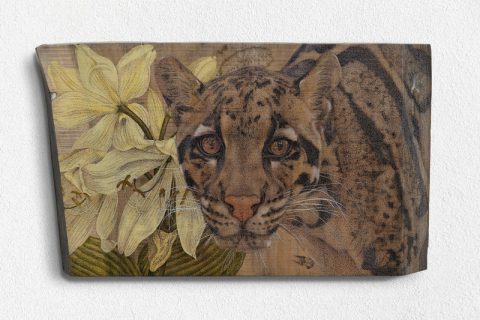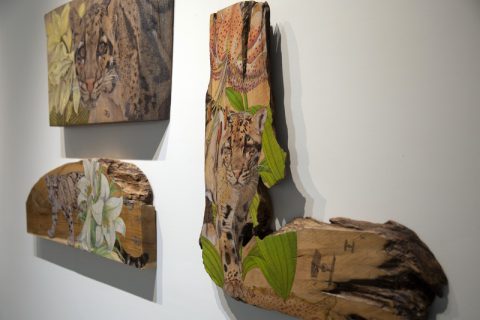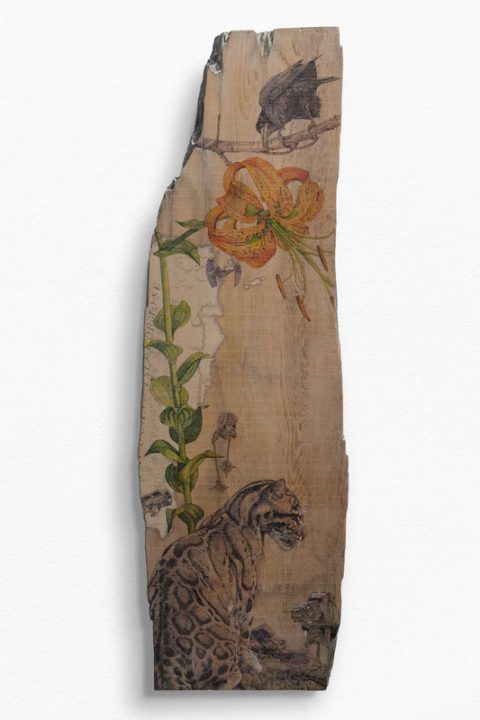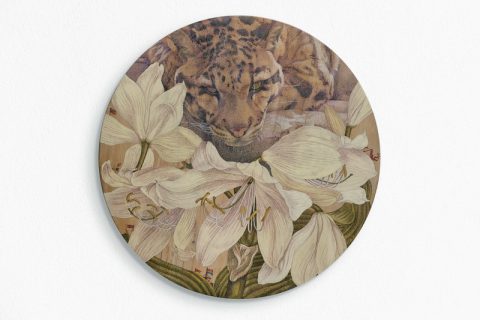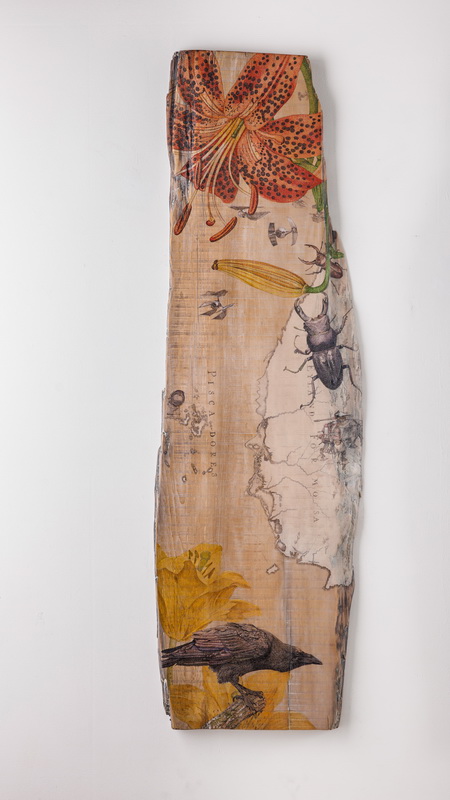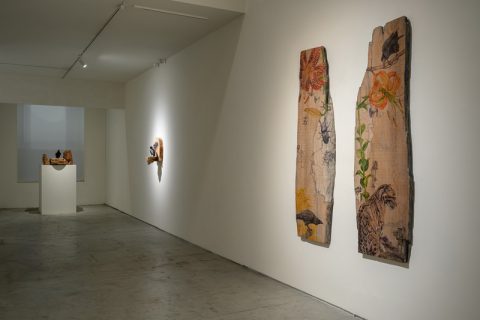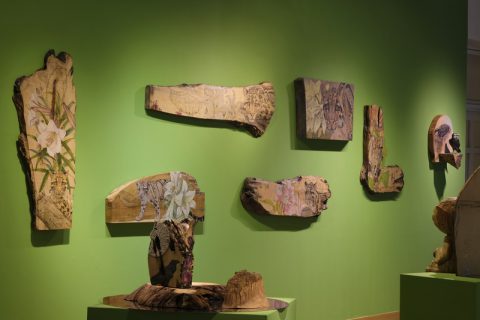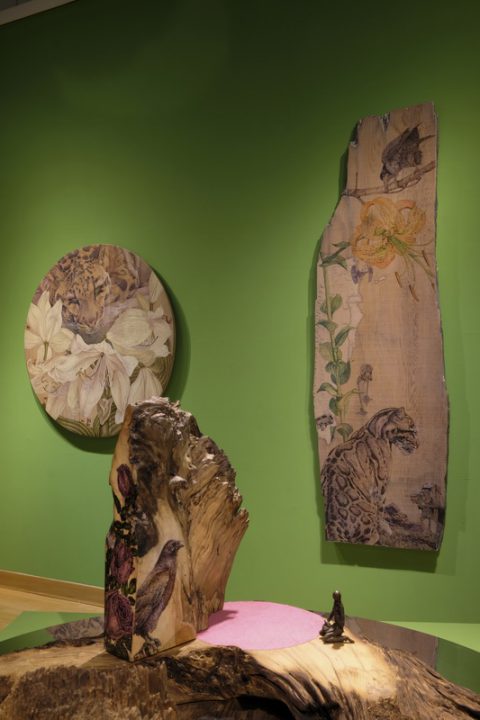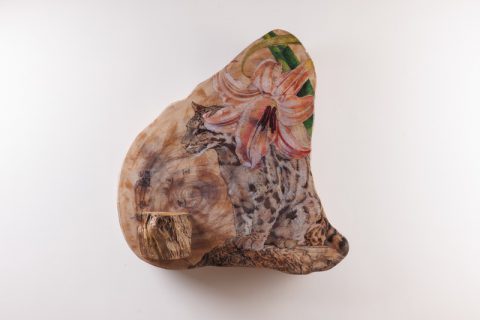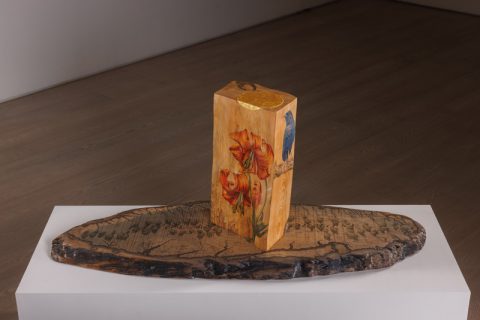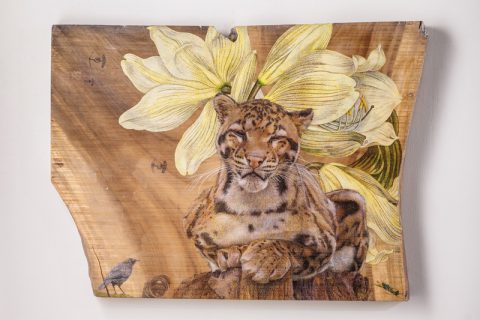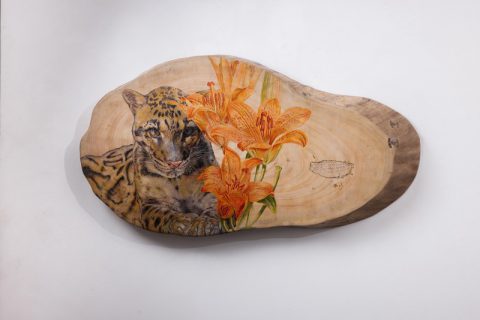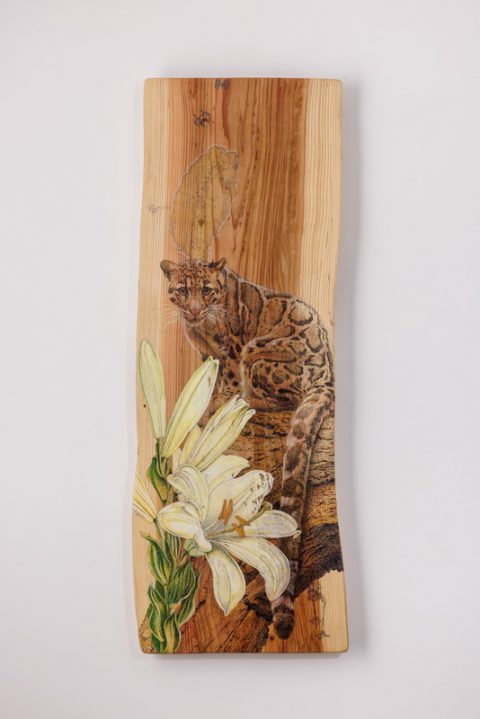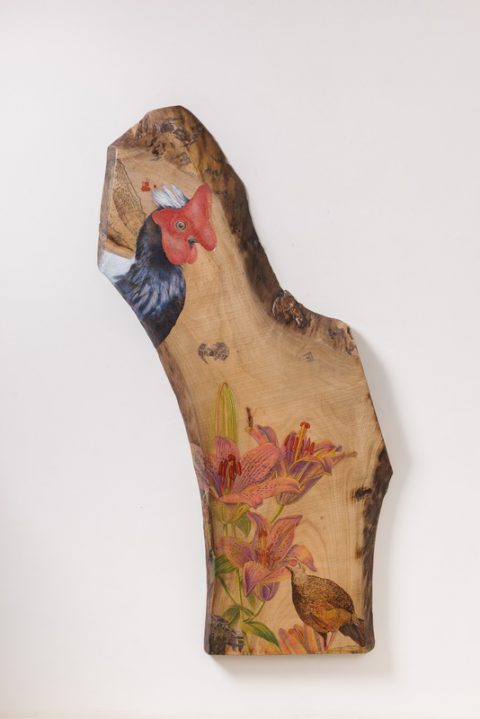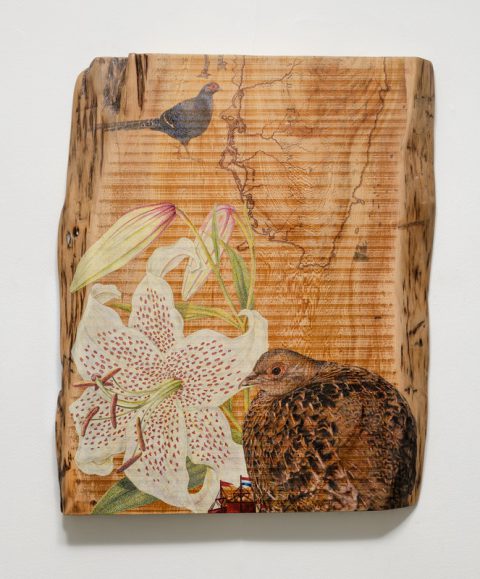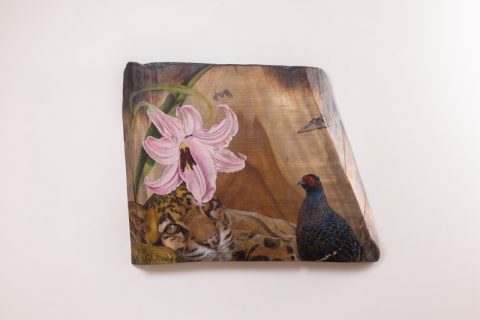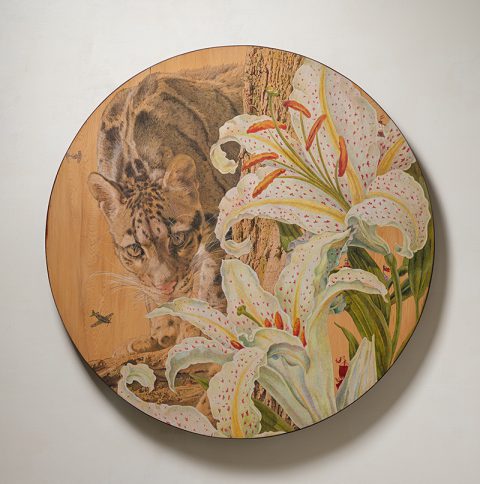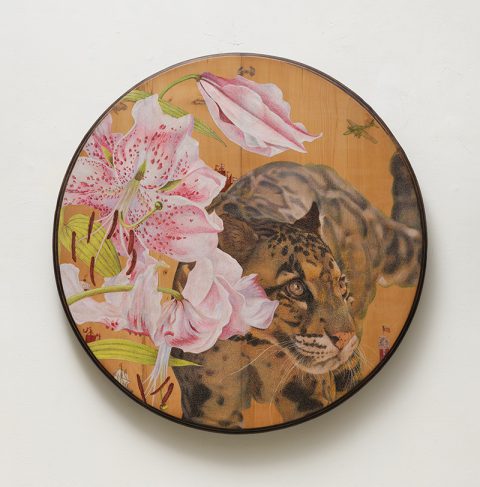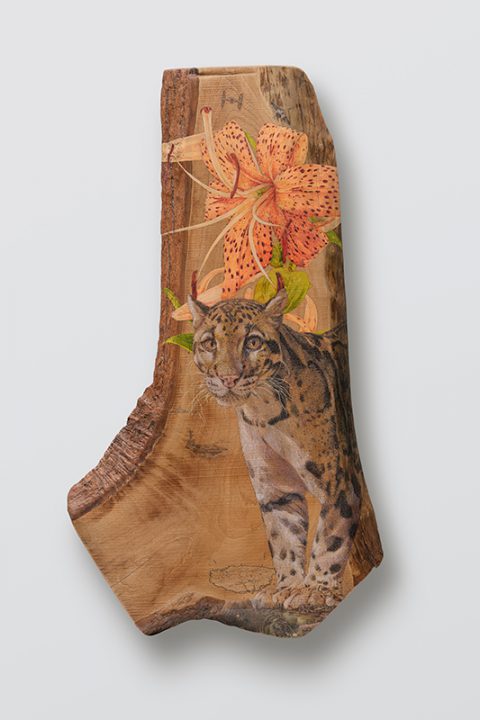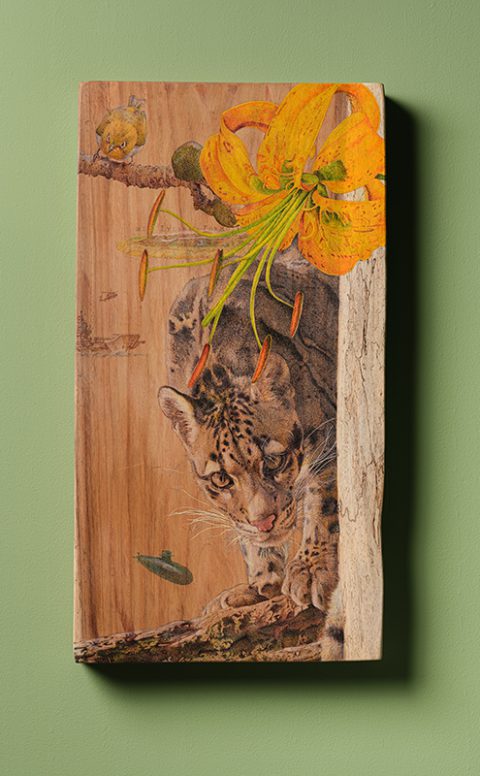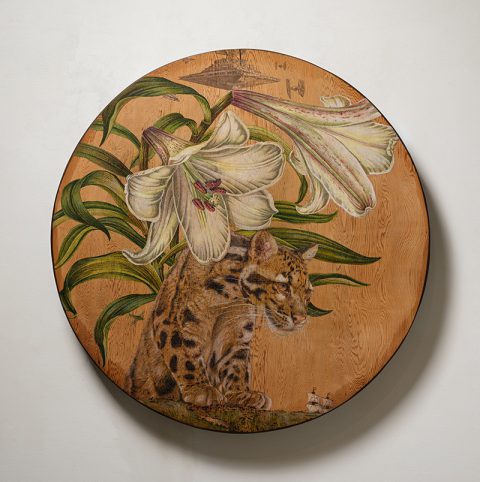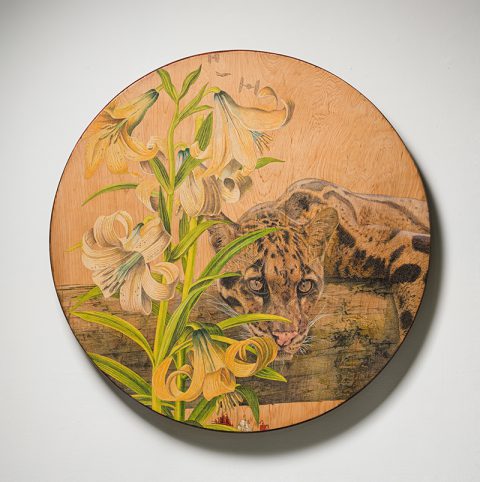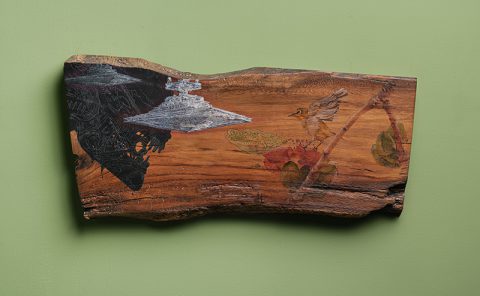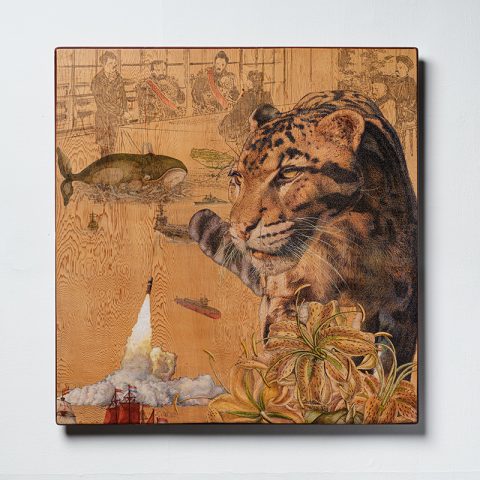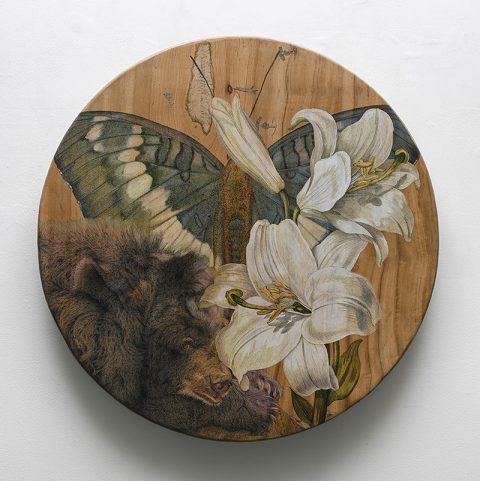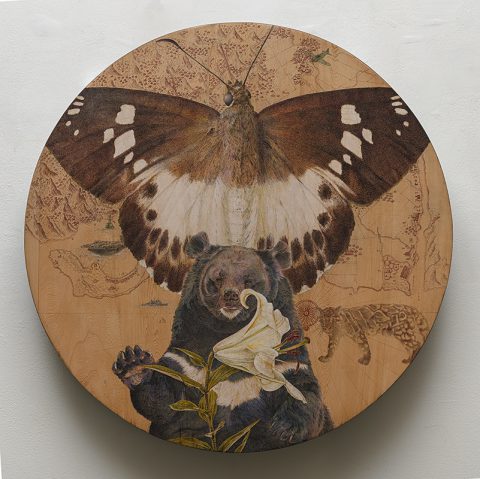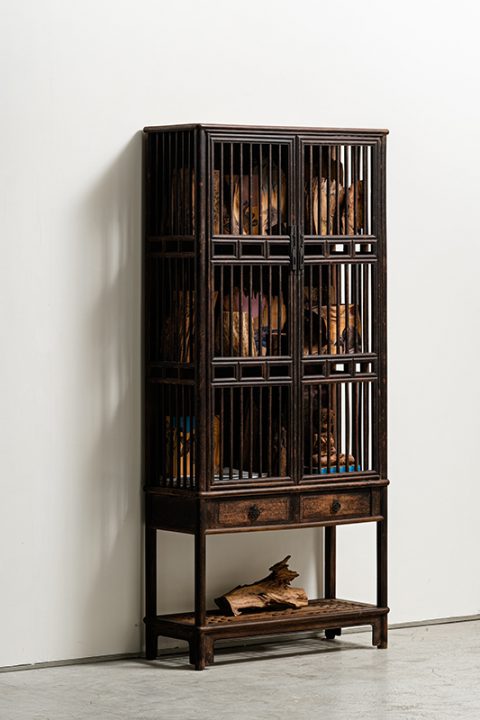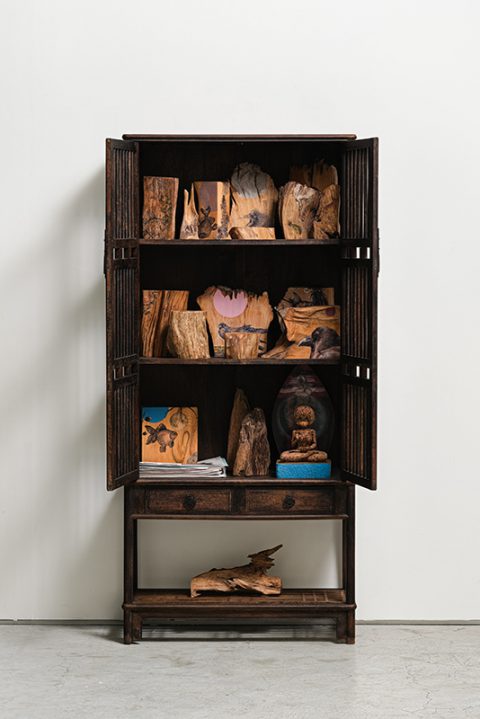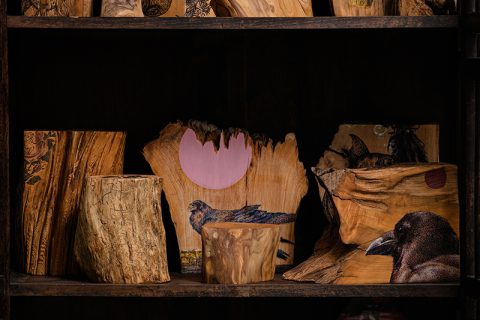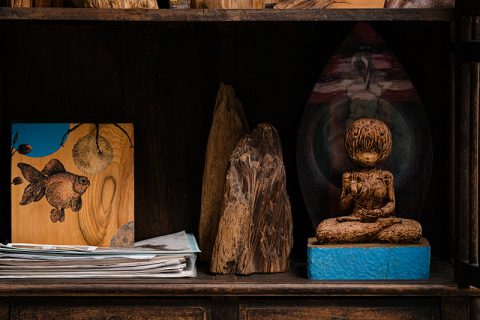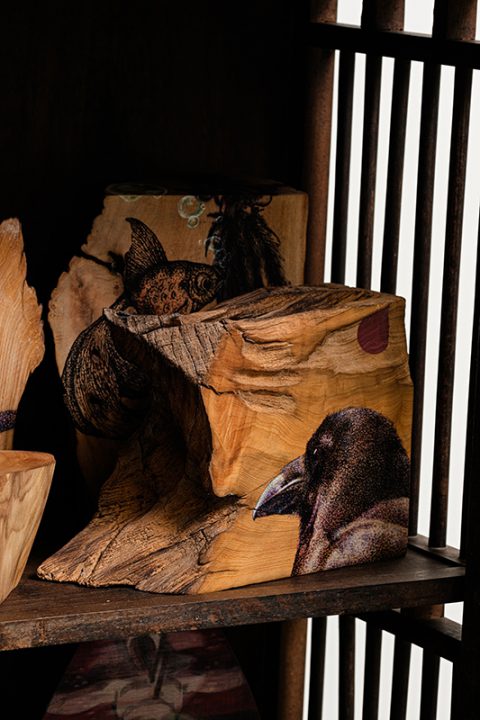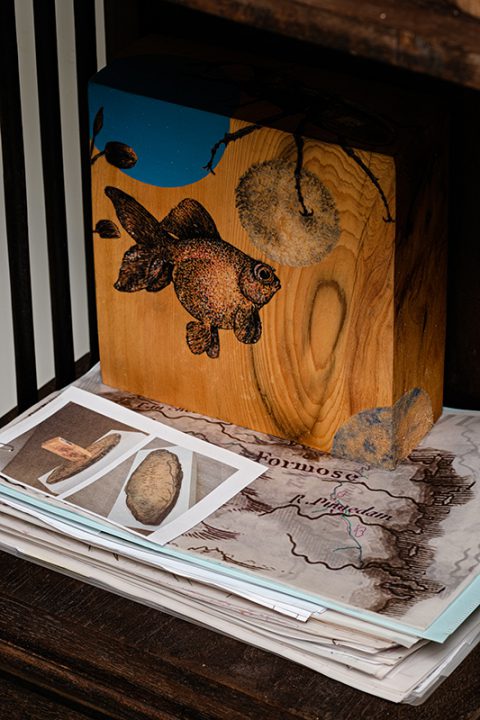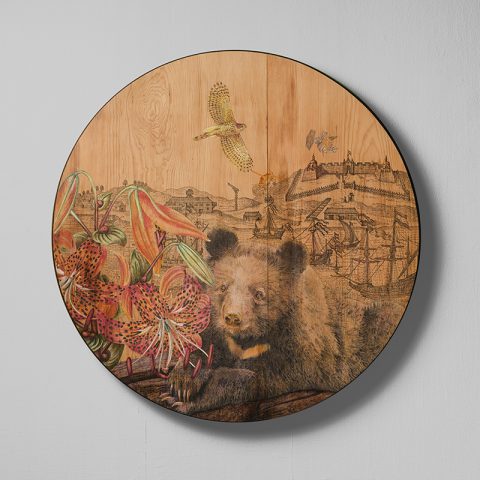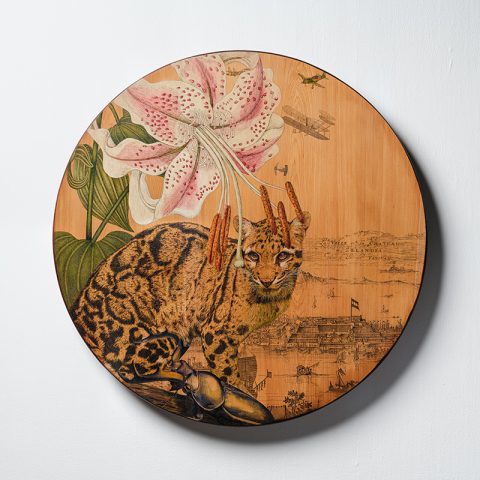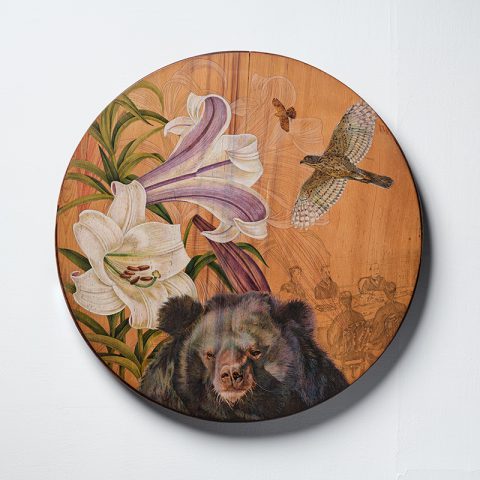2020 – Present
「尋找曼荼羅」主題下的第二個系列是「花落春未盡」。
20世紀末身為青壯年時期的楊茂林,放下他已經立功立名的繪畫,轉身從木料開始摸索學習雕塑,因繪畫在當時已是他十分熟稔的材料與表達手段,失去了可破可立的冒險心情;但經過漫長的醞釀,現在他又從「黯黑的放浪者」開始回到畫布,實現他腦中思及「繪畫」的所有新可能性,「以無法之法恣情揮灑,以歡快的腎上腺素迎接即將遭遇到的繪畫世界所有魔界妖怪,被祂打敗,然後打敗祂。」楊茂林如是說。
但是畫布的挑戰對他而言顯然還是不夠刺激,「花落春未盡」系列的起手式,楊茂林又揚棄了相對安全的、在框架裡走筆的畫布,而是以「木板」繪畫,作為他新實驗的起點。
楊茂林的木板畫與古代的木板上繪畫完全不同,楊茂林是在他收藏多年的原木料及老木圓桌板上作畫,保留木板不規則的原型、不掩藏木板的質地與肌理,而是依傍著木材生長、雷劈蟲噬的大自然吻痕一起入構圖,將這些都融入其繪畫內容的情境與敘事;而為了運用木材的色澤紋理以豐富作品的繪畫性與溫度,保留的木質底就與古代打底成畫布效果的木板畫完全不同,而且不同的木材之間在吸水、斥水、吸油、斥油的特性上又有很大的差異:在木板原材上繪畫可以說隨時都在實驗,隨時都在摸索適合不同木材的新方法,同時也因此隨時會有新的驚喜。
為了保留木紋的趣味,楊茂林「花落春未盡」系列木板上的繪畫手法,以反覆薄擦、薄染地層疊,密密點繪出色彩的濃淡與明暗。因此,此系列作品有一觀看方式―觀者若以手機對著畫面放大來看,會赫然發現許多部位是以無數細點,點畫而成,在驚異妙處窺見楊茂林所謂「以無法之法恣情揮灑」的奧義。
The Lasting Spring – Wood|2020 – Present
The second series under the theme of The Quest for Mandala is The Lasting Spring.
Yang Mao-Lin, at the prime of his life in the late 20th century, moved away from painting that made his reputation and success, and began exploring sculpture in wood. This is because he was already highly familiar with the material and expressive means of painting, which became less adventurous for him to make any breakthroughs. However, after a long period of reflection, he has now revisited the canvas starting with Wanderers of the Abyssal Darkness to realize all the new possibilities that he has contemplated on to “unfetteredly paint with the method of no-method, and usher in all the demons and monsters one would potentially encounter in the world of painting with the rush of adrenaline, and be defeated by and eventually defeat them.”
As a matter of fact, the challenges of painting on the canvas are clearly not thrilling enough for the artist. To start the series of The Lasting Spring, Yang renounces the relatively safer approach to paint on the canvas and within a fixed frame. Instead, he chooses to paint on “wood slabs” to launch a new experiment.
Yang’s painting on wood slab is completely different from the ancient genre of panel painting. He directly paints on raw wood slabs and old, round wooden tabletops from his personal collection. Preserving the irregular shapes of the wood material, together with its original texture and quality, he develops the painting series by observing and following the condition of the material, while incorporating the natural marks created by lightning strikes and gnawing of insects to convert these elements into part of the scenarios and narratives in the series.
In order to enrich the painterliness and warmth of his work with the color and grain of the wood, the artist preserves the wood foundation, which already differs entirely from the ancient practice of creating a canvas-like foundation on wood panels in panel painting, let alone the varying absorption of water and oil. Consequently, to paint on raw wood material is itself an experiment, which means that the artist must constantly search for new and suitable ways to paint on different types of wood; hence, the unexpected surprises in the making of this series.
To keep the intriguing wood grain, in the series of The Lasting Spring, Yang repeatedly applies thin rubbing and rendering to create the wood slab paintings, utilizing dense dots to create the thickness and lightness as well as the brightness and darkness of color. Consequently, an unusual way to view this series of works is through the magnifying lens of one’s smartphone, which will reveal the countless dots that constitute different parts of a work—such a remarkable technique is the ultimate meaning of what Yang has described as “the method of no-method.”
▲ ▼
花落春未盡.烏鴉S2001|綜合媒材|54×41.5×23.5cm|2020
The Lasting Spring.Raven S2001|mixed media|54×41.5×23.5cm|2020
花落春未盡.烏鴉S2002|綜合媒材|主體40×67.5x66cm+底座Ø90cm|2020
The Lasting Spring.Raven S2002|mixed media|main 40×67.5x66cm+base Ø90cm|2020
花落春未盡.烏鴉S2002|綜合媒材|主體40×67.5x66cm+底座Ø90cm|2020
The Lasting Spring.Raven S2002|mixed media|main 40×67.5x66cm+base Ø90cm|2020
花落春未盡.烏鴉S2101|綜合媒材|56x45x37cm|2021
The Lasting Spring.Raven S2101|mixed media|56x45x37cm|2021
花落春未盡.雲豹與百合M2001|綜合媒材|主體21x15x15cm+28.5x25x5.5cm+38.5x27x12cm+底座Ø88cm|2020
The Lasting Spring.Clouded Leopard and Lily M2001|mixed media|main 21x15x15cm+28.5x25x5.5cm+38.5x27x12cm+18x39x37cm+base Ø88cm|2020
花落春未盡.雲豹與百合M2001 (局部)
The Lasting Spring.Clouded Leopard and Lily M2001 (part)
花落春未盡.雲豹與百合M2001 (局部)
The Lasting Spring.Clouded Leopard and Lily M2001 (part)
花落春未盡.雲豹與百合M2001 (局部)
The Lasting Spring.Clouded Leopard and Lily M2001 (part)
花落春未盡.雲豹與百合M2002|綜合媒材、紅檜|47x157x6cm|2020
The Lasting Spring.Clouded Leopard and Lily M2002|mixed media on Taiwan red cypress|47x157x6cm|2020
花落春未盡.雲豹與百合M2003|綜合媒材、牛樟|37x123x8cm|2020
The Lasting Spring.Clouded Leopard and Lily M2003|mixed media on stout camphor tree|37x123x8cm|2020
花落春未盡.雲豹與百合M2101|綜合媒材、紅檜|123x60x4.5cm|2021
The Lasting Spring.Clouded Leopard and Lily M2101|mixed media on Taiwan red cypress|123x60x4.5cm|2021
花落春未盡.雲豹與百合M2102|綜合媒材、紅檜|120x54x4.6cm|2021
The Lasting Spring.Clouded Leopard and Lily M2102|mixed media on Taiwan red cypress|120x54x4.6cm|2021
花落春未盡.雲豹與百合M2103|綜合媒材、紅檜|83x77x5.1cm|2021
The Lasting Spring.Clouded Leopard and Lily M2103|mixed media on Taiwan red cypress|83x77x5.1cm|2021
花落春未盡.雲豹與百合M2104|綜合媒材、胡桃木|37x104x6cm|2021
The Lasting Spring.Clouded Leopard and Lily M2104|mixed media on walnut|37x104x6cm|2021
花落春未盡.雲豹與百合M2105|綜合媒材、胡桃木|51x90x8cm|2021
The Lasting Spring.Clouded Leopard and Lily M2105|mixed media on walnut|51x90x8cm|2021
花落春未盡.雲豹與花鳥蟲魚1|綜合媒材、台灣松木|190x60x5cm|2021
The Lasting Spring.Clouded Leopard, Flower, Bird, Insect and Fish 1|mixed media on Taiwan white pine|190x60x5cm|2021
花落春未盡.雲豹與花鳥蟲魚2|綜合媒材、台灣鐵杉|直徑105x2cm|2021
The Lasting Spring.Clouded Leopard, Flower, Bird, Insect and Fish 2|mixed media on Taiwan hemlock|Ø 105x2cm|2021
花落春未盡.雲豹與花鳥蟲魚3|綜合媒材、台灣松木|191x58x4.5cm|2021
The Lasting Spring.Clouded Leopard, Flower, Bird, Insect and Fish 3|mixed media on Taiwan white pine|191x58x4.5cm|2021
花落春未盡.雲豹與百合M2106|綜合媒材、香樟、牛樟|86x82x20.5cm|2021
The Lasting Spring.Clouded Leopard and Lily M2106|mixed media on Taiwan camphor and stout camphor tree|86x82x20.5cm|2021
內地之塔.花鳥蟲魚|綜合媒材、紅檜|47.5x114x42cm|2022
Tower of the Inland.Flower, Bird, Insect and Fish|mixed media on Taiwan red cypress|47.5x114x42cm|2022
花落春未盡.雲豹與百合M2201|綜合媒材、胡桃木|87×116.3x9cm|2022
The Lasting Spring.Clouded Leopard and Lily M2201|mixed media on walnut|87×116.3x9cm|2022
花落春未盡.雲豹與百合M2202|綜合媒材、香樟|63x118x8cm|2022
The Lasting Spring.Clouded Leopard and Lily M2202|mixed media on Taiwan camphor|63x118x8cm|2022
花落春未盡.雲豹與百合M2203|綜合媒材、吉野杉|126x46x5.7cm|2022
The Lasting Spring.Clouded Leopard and Lily M2203|mixed media on Japanese cedar|126x46x5.7cm|2022
花落春未盡.藍腹鷴與百合L2201|綜合媒材、香樟|176x88x8cm|2022
The Lasting Spring.Swinhoe’s Pheasant and Lily L2201|mixed media on Taiwan camphor|176x88x8cm|2022
花落春未盡.帝雉與百合M2201|綜合媒材、檜木|100x85x6cm|2022
The Lasting Spring.Mikado Pheasant and Lily M2201|mixed media on cypress|100x85x6cm|2022
花落春未盡.帝雉雲豹百合花M2201|綜合媒材、香樟|79x98x7cm|2022
The Lasting Spring.Mikado Pheasant, Clouded Leopard, and Lily M2201|mixed media on Taiwan camphor|79x98x7cm|2022
花落春未盡.雲豹與百合L2201|綜合媒材、黃檜|Ø 132x2cm|2022
The Lasting Spring.Clouded Leopard and Lily L2201|mixed media on Taiwan cypress|x2cm|2022
花落春未盡.雲豹與百合M2204|綜合媒材、檜木|Ø94x4cm|2022
The Lasting Spring.Clouded Leopard and Lily M2204|mixed media on Taiwan cypress|Ø94x4cm|2022
花落春未盡.雲豹與百合M2205|綜合媒材、香樟|129x70x6cm|2022
The Lasting Spring.Clouded Leopard and Lily M2205 mixed media on Taiwan camphor|129x70x6cm|2022
花落春未盡.雲豹與百合M2206|綜合媒材、胡桃木|86x46x6cm|2022
The Lasting Spring.Clouded Leopard and Lily M2206|mixed media on walnut|86x46x6cm|2022
花落春未盡.雲豹與百合M2207|綜合媒材、檜木|Ø100x6cm|2022
The Lasting Spring.Clouded Leopard and Lily M2207|mixed media on Taiwan cypress|Ø100x6cm|2022
花落春未盡.雲豹與百合M2301|綜合媒材、紅檜|Ø116x3cm|2023
The Lasting Spring.Clouded Leopard and Lily M2301|mixed media on Taiwan red cypress|Ø116x3cm|2023
花落春未盡.綠繡眼與熱蘭遮S2301|綜合媒材、胡桃木|83x37x6cm|2023
The Lasting Spring.Japanese White-eye and Zeelandia S2301|mixed media on walnut|83x37x6cm|2023
花落春未盡.雲豹百合春帆樓M2301|綜合媒材、紅檜|102x92x2.8cm|2023
The Lasting Spring.Clouded Leopard, Lily and Shunpanro M2301|mixed media on Taiwan red cypress|102x92x2.8cm|2023
花落春未盡.黑熊百合摩斯拉M2301|綜合媒材、牛樟|Ø104x3cm|2023
The Lasting Spring.Black Bear, Lily and Butterfly M2301|mixed media on stout camphor|Ø104x3cm|2023
花落春未盡.黑熊百合摩斯拉M2302|綜合媒材、檜木|Ø100x9cm|2023
The Lasting Spring.Black Bear, Lily and Butterfly M2302|mixed media on Taiwan cypress|Ø100x9cm|2023
未來的應許|綜合媒材|175x80x33cm|2023
The Promise of Future|mixed media|175x80x33cm|2023
未來的應許|綜合媒材|175x80x33cm|2023
The Promise of Future|mixed media|175x80x33cm|2023
未來的應許(局部)
The Promise of Future (part)
未來的應許(局部)
The Promise of Future (part)
未來的應許(局部)
The Promise of Future (part)
未來的應許(局部)
The Promise of Future (part)
花落春未盡.黑熊百合熱蘭遮L2301|綜合媒材、台灣櫸木|Ø126×2.5cm|2023
The Lasting Spring.Black Bear, Lily and Zeelandia L2301|mixed media on Taiwan zelkova|Ø126×2.5cm|2023
花落春未盡.雲豹百合熱蘭遮L2301|綜合媒材、肖楠|Ø128x3cm|2023
The Lasting Spring.Clouded Leopard, Lily and Zeelandia L2301|mixed media on Taiwan incense cedar|Ø128x3cm|2023
花落春未盡.黑熊百合春帆樓M2301|綜合媒材、台灣亞杉|Ø104×1.8cm|2023
The Lasting Spring.Black Bear, Lily and Shunpanro M2301|mixed media on Taiwania|Ø104×1.8cm|2023

